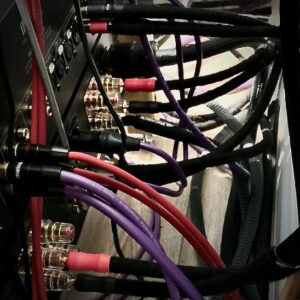
Interconnect cables compared
- The connecting cable plays no substantial role in the sound.
- A connecting cable can slow the dynamics, blur the details, or make listening to otherwise excellent stereo unpleasant.
- The connecting cable is an accessory.
- A connecting cable is a full-time component.
- The cable is an accommodating element.
There are two different approaches to the issue or selection of audio cables, with each course being a dichotomous pair:
- a) Transparency should represent the idea of cable.
- b) The cable is here for us to tune up the sound.
OR
- a) Only the rational way leads to success.
- b) It is necessary to explore technologies going beyond the limits of the “reasonable” mind.
Of course, various cable designers’ philosophies correspond with these requirements. However, the reader indeed asks more down-to-earth questions: How will the sound change – both in the case of using the best or, on the other hand, inexpensive components? Interconnect cables compared
- Can the cable’s tough character be considered?
- Can the line be evaluated as being means of measurement?
We decided to address a few of these issues but not all of them. We defined the task to come up with more general conclusions than just ranking a large number of cables.
Differences Identified
The main stumbling block is that we cannot realise the situation “without the cable”. And we need that centrepiece around which the space would revolve. Also, we did the best we could. First, we turned the components with their backs to each other, and then the connection length approached the ideal situation by the “no cable – best cable” philosophy. Interconnect cables compared
For example, the maximum differences (and I’m somewhat exaggerating) only approximate the difference when we insert a quality net filter before the components. On the other hand, this difference can reach the size of an audible difference between amplifiers of the same class and principle; e.g., we would claim that the character of these imaginary amplifiers is very similar. Just one of them is better tuned.
Exaggeration
If you suspect some reviewers will expressively exaggerate the described differences and qualities, I must agree. If we tune to the “magnifying glass mode” in the course of the test, then we take these nuances into account. However, it is also true that these differences can have such an impact that it can suggest a situation such as when you are listening to music while reading a newspaper.
And you forget about the world around you (I think I stole this sentence from someone). Such feelings from which the micro-dynamic, transient, and phase originators are abstracted are often more critical and quality-defining than the separate parameters of individual bands that can be followed more easily (firmness of bass, clearness of mid-range, etc.). By the way, only the best cables from the test opened up the door to such an irrational fascination—a pretty expensive door for such a moment of pleasure. And without instructions, the described differences would be unrecognisable to the listener – especially during a short listening period. The overall character of a cable shows up only after a more extended period. Interconnect cables compared
The River
It is as if you come to a river and look at it. Only after some time do you recognize the order of its flow, and your mind accepts the rhythm in which it flows through the basin and jumps over the boulders. Only then your mind rests in peace, and you can enjoy the music in which chirping elements play. Although it is poetic, I find this example suitable. Interconnect cables compared
At the same time, this analogy hints at why the rapid comparison (“switching”) test method fails. Also, cannot be measured data in cables and other components. If the world is recognizable, as the materialists claim, we must forget that recognition. Besides capacitance, DC resistance, and inductance, some “special” parameters also exist derived from other characteristics (output, phase, and attenuation). We measured some of them, but correlating them to listening evaluations, in this case, would be looking for the needle in the haystack.
Construction
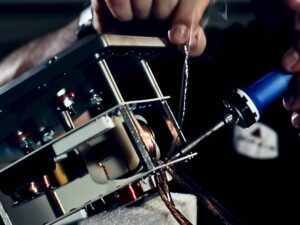
The symmetrical cable is usually terminated with XLR connectors and connects symmetrical types of signals (balanced). In the RCA case, the inner structure is “symmetrical”. Inside the core, a symmetrical cable contains two conductors, usually twisted, connected to the pin and ground, and woven or foil shielding is open at both ends (unconnected). All other configurations with more than two electrically conductive elements are usually called pseudo-symmetrical. For example, it might be a conductor and double shielding, two conductors and connected shielding, or any multiple alternatives, with a different connection type at every end from which the cable’s directivity results.
Antenna
Every conductor is an antenna for different kinds of high-frequency, e.g., RF, from which it is essential to protect the cable as much as possible. Therefore, there are twisted conductors, shielding, and various filters. As a result, designers must solve many conflicting requirements: for example, triple-core cables are more resistant to electromagnetic interference, but the cable capacitance increases.
A lesser know parameter is the so-called cable resonance frequency. It’s the frequency (usually around 2 kHz) where the influence of capacitance starts to surpass the effect of inductance, and the parameters of this transition indirectly influence the sound character. Also, the resonance frequency is measured, but the value only provides us with some information about the cable character.
Connectors represent an independent chapter in the cable case, and they have been under-examined in previous studies of cables. The connector contact should be flexible and clean – the former quality is secured by the pin, eventually in combination with grooves or other specialities. The connection of the ground conductor must deal with the mechanical load, surface finish, and necessary maintenance often underestimated. Cleanliness and size of the contact surface have an essential influence on signal quality.
Properties
Regarding the electrical properties, capacitance is necessary with interconnects, and there is a dependence on the connected components’ low or high input or output impedance. And we have accepted the quality descriptions from the manufacturer’s spec sheets for this study and did not intend to comment on them too much. We tried to avoid, however, paying attention to phrases such as “Our silver conductors guarantee the best sound”. Many of the statements seem disputable, and it is clear that some companies try to sell based on the presentation of their technology in brochures. But, to ignore all seemingly strange claims would not be a good idea either. How often do we realise that things are different from the textbook theory? Interconnect cables compared
Cables Tested
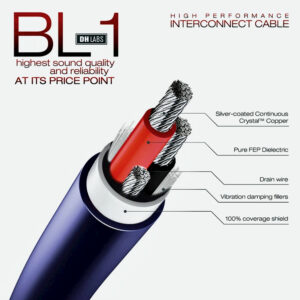
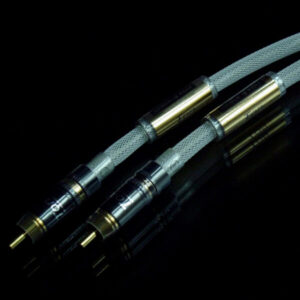
Also, we thank Jim Aud from the legendary Purist Audio Design, who sent us the Proteus. You must understand that our hands were shaky when opening a rather ordinary UPS parcel containing a cable worth almost one hundred thousand crowns. And the number of cables we finally had on hand was unbearable. Moreover, we could not obtain the same length of all the cables for test. Interconnect cables compared
- a – Neutrik connector for KrautWire Model 4, ALK No.2 and No.3
- b – Oehlbach
- c – StraightWire Rhapsody II
- d – Maple Audio Works
- e – WBT ALK No.4
- f – DH Labs
- g – Belden
- h – Clearaudio
- i – Van den Hul
- j – Cable4You PTFE with diagonal grooves
- k – Original WBT for GutWire Chime and Granite Audio # 470
- Top left-hand – JPS labs
- Top right-hand – StraightWire (Maestro II)
Method of Testing
In the first phase, we carried out the burn-in process. Although burn-in is valuable, we decided to do it just in case. Many designers, however, suggest that it is essential. During the test, all connectors were treated with the antioxidant lubricants DeOxit and ProGold, which we consider necessary. Otherwise, we might test the effects of oxidation on the plugs rather than the quality of the cables. Four reviewers took part in the tests, encompassing four months(!) Each reviewer listened to the wires on various components. The specifications, including their prices, were kept secret. Each reviewer listened to the cables for about one month.
In the second phase, we used a single-blind controlled listening situation. The recordings chosen carefully, but we could only test three different cables in a quarter of an hour. Then, we would rest and drink coffee. One person served as the cable manipulator and also recorded the results. We used two recordings for each test of three cables in the quarter-hour period. The sense organs would strain. More coffee. More and more trips to the can because of all that coffee. One of the reviewers might be cold, and another not in a good mood. However, we tried to test all the cables with different music and when everyone was as relaxed as possible. With about 25 other pairs of wires, we calculated finishing in 2023. Fortunately, we got done sooner.
Music
Dave Grusin’s “The Gershwin Connection”, Victor Bailey’s “Low Blow”, Towner-Gary Peacock’s “A Closer View “, Bob James’ “Playin’Hooky”, Mighty Sam McClain’s “Give Me Up To Love”, Johnny Adams “One Step In The Blues”, Scott Henderson’s Tribal Tech “Thick”, Tuck Andress “Reckless Precision”, Spyro Gyra “Got The Magic”, Lary Coryell “I Will Be Over You”, Bach/Vivaldi/Marcello “Violin and Oboe Concertos”, Patricia Barber “Modern Cool”, Dead Can Dance “Spiritchaser”, Tori Amos “Boys for Pele”, JMLab Cd No.3, Diana Krall “Love Scenes”, “Acoustic Mania” with Antonio Forcione, Jacky Terrason “Dedicato”, Cassandra Wilson “Rendez-Vous”, David Bowie “Hours”
Results
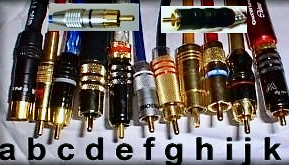
- The Proteus from Purist Audio Design is absolutely neutral and, therefore, a universal cable. There was transparency and phase coherence.
- The Silver cable # 470 from Granite Audio was excellent. On details, it worked like a magnifying glass, but it did not interfere with the music flow. However, Petr Püschel did not care for them connected to his low-impedance Denon DCD 1800.
- The Czech Cable4You – Whitesnake One is a product from the north of Bohemia, and it surprised us with its resolution and separation of instruments in space. We could not agree on its bass goodness but generally decided it had a great overall sound. Unfortunately, the KrautWire Model 4 was not neutral, with a slight inaccuracy in the middle and higher frequencies.
- As for the cable Maestro II from Straight Wire, it had detailed bass, but it also sounded a bit too laid back.
- JPS Labs Ultraconductor has solid core conductors and no shielding. Because of this, it is subject to interference and hum. The connectors are average. So, you must keep it away from such things as computers and AC cords. Even with these caveats, the sound was terrific. This cable and the DH Labs Silver Sonic BL-1 SII were of tremendous value.
- The Cable 4You – PTFE and Clearaudio Silverline ended up with nearly the same score and noted as very rich and detailed in sound quality.
- Van Den Hull’s The First Ultimate likely had moderate suppression due to the carbon content. But, the sound came off as velvety, which might be enjoyable to some listeners. Clearaudio Sixstream was also soft but had a full-bodied character and excellent bass. ALK No.2 and No.3 had ideal spatial resolution but needed to catch up in the accuracy of the mid-range and high frequencies.
- Straight Wire Rhapsody II was dynamic and non-fatiguing but lacked clarity to most of us, but one referee liked it. The VanDenHull Thunderline was good value for the dollar, and we could not find any particular criticisms here. On the other hand, we did not care for the Trident.
- The Oehlbach No.1 is a simple branded entry-level cable. Even so, its sound quality was similar to the others (this is why we used single-blind testing). The Belden 89259 was the only real disappointment in the test, but it was also very inexpensive.
Both active cables represent a separate chapter. Pavel Dudek’s Sound Refiner was more defined. But, the B-Cable was more subtle in the bass and, as a whole, could have been more firm. However, both products were quite similar otherwise. Interconnect cables compared
Summary
The basic parameters of cables, i.e Capacitance, DC resistance, and inductance, were not correlated with sound quality. The theory that a line is better if it has lower capacitance is invalid. Of course, this does not say anything about the accuracy of the electrical propagation of the signal with reactance. There does not appear to be a correlation with audible preferences.
The results clearly show that it is possible to characterise the cables “sound”. Also, treatment of the terminating connector has a significant role. And the best solution need not always be subjective “no cable”. Adjusting the sound quality with the cable will be helpful for some people. And if you have enjoy reading ‘Interconnect cables compared’, please share with friends – thank you
Author: Milan Cernohorsky, The VAULT, ‘Secrets of Home Theatre’
Perkune audiophile cables I Professional service